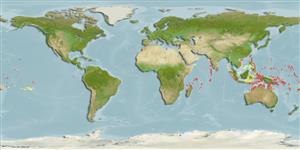Preferred temperature (Ref.
123201): 27.2 - 29.3, mean 28.6 °C (based on 1456 cells).
Phylogenetic diversity index (Ref.
82804): PD
50 = 0.6250 [Uniqueness, from 0.5 = low to 2.0 = high].
Bayesian length-weight: a=0.00389 (0.00180 - 0.00842), b=3.12 (2.94 - 3.30), in cm total length, based on all LWR estimates for this body shape (Ref.
93245).
Niveau trophique (Ref.
69278): 3.6 ±0.5 se; based on size and trophs of closest relatives
Résilience (Ref.
120179): Milieu, temps minimum de doublement de population : 1,4 à 4,4 années (Preliminary K or Fecundity.).
Fishing Vulnerability (Ref.
59153): Low vulnerability (14 of 100).
Nutrients (Ref.
124155): Calcium = 85.3 [44.1, 152.3] mg/100g; Iron = 0.693 [0.384, 1.429] mg/100g; Protein = 17.9 [14.9, 20.1] %; Omega3 = 0.0829 [, ] g/100g; Selenium = 20.5 [10.6, 46.1] μg/100g; VitaminA = 217 [60, 874] μg/100g; Zinc = 1.58 [1.02, 2.56] mg/100g (wet weight);
